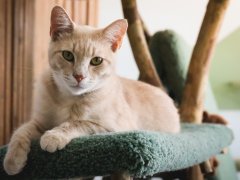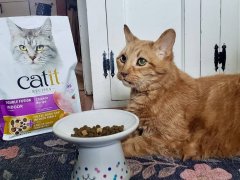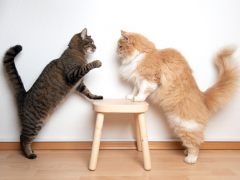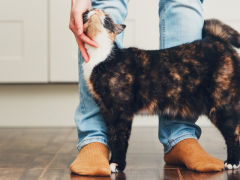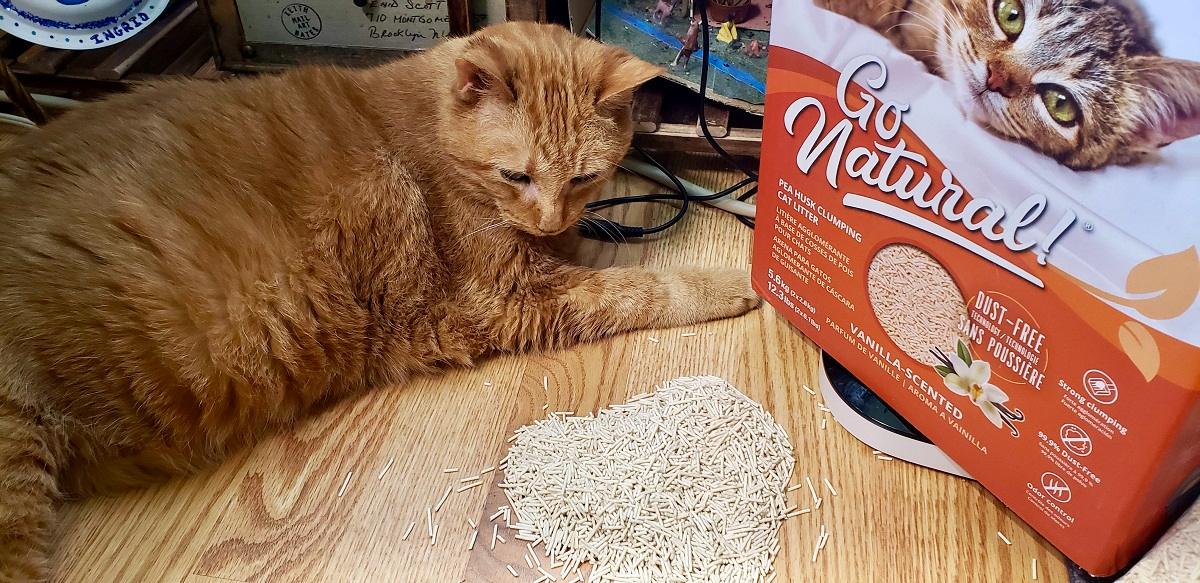
Liz Coleman / Cats.com
As consumers seek to minimize their carbon footprint, natural cat litter is having its day—a movement we can get behind. Unfortunately, there’s a lot of misinformation about natural litter out there. We’re here to clear up the confusion and highlight its strengths, weaknesses, and who stands to benefit most.
To clarify, when we refer to “natural” litter in the pet industry, we mean litter made from organic materials that break down more easily than traditional clay. While clay litter is sourced from the earth and can be technically considered “natural,” it’s not the most eco-friendly option. Natural litters are crafted from renewable resources like wood, corn, and recycled paper. Not only are they better for the planet, but they also offer practical benefits for cat parents.
Unsure if natural litter is for you? Below, we’ll lay out the main benefits—and frankly call out common drawbacks. Here are seven reasons to consider a sustainable litter, like Catit’s Go Natural Pea Husk Litter.
1. It’s Better for the Environment

Liz Coleman / Cats.com
Natural cat litter offers a clear environmental advantage, both in terms of production and its disposal.
Whereas bentonite clay is extracted through strip-mining, a destructive process that harms ecosystems, natural litters are made from renewable resources like wheat, soybeans, and recycled paper.
These materials often come from sustainably managed practices. For example, wood-based litters are derived from responsibly harvested forests, and tofu-based products utilize leftover scraps. Catit’s natural litter upcycles post-consumer materials that would otherwise be discarded, including pea husks and bamboo.
Many natural brands also focus on eco-friendly packaging. Catit, for instance, features recyclable cardboard boxes and vacuum-packed bags that save space and reduce CO2 emissions during transport.
When it’s time to replace litter, natural options are biodegradable and break down over time, reducing waste in landfills.
2. It’s Healthier for Cats
Clay litter often contains harmful chemicals, dyes, and fragrances. Natural litters, on the other hand, are usually made from food-grade, non-toxic materials. These are gentler on your cat’s lungs, skin, and even their tummy, should they try a nibble.
Instead of relying on harsh additives to combat smell, natural litters include materials that naturally absorb and neutralize odors. They also incorporate eco-friendly add-ins, like baking soda, to manage smells.
Additionally, natural litter tends to produce less dust, which is better for cats with asthma or allergies as well as sensitive humans. Switching to a natural litter can make everyone in the household—feline or otherwise—breathe a little easier.
While natural litter is generally safer, two potential health hazards to watch for are pests and mold. If not stored correctly, natural litters like corn and wheat can be susceptible to these issues.
3. It’s (Usually) Less Mess Than Clay

Liz Coleman / Cats.com
When it comes to cleanliness, natural litter has an edge over clay. Typically, natural materials produce less dust, and any dust generated is safer to breathe than tiny clay particles.
Some natural formulas, such as Catit’s Pea Husk litter, are purposefully designed with larger pellets that track less, keeping litter inside the box instead of your floors. However, you’ll also find natural litters that are lightweight and come in fine granules. These can actually lead to more mess than clay.
Something to consider: Even though they don’t typically include artificial fragrances, some natural litters will have a distinct smell by virtue of their ingredients. (i.e., pine pellets will smell woodsy and tofu has a decidedly sweet smell). We recommend picking something you can live with.
4. Natural Litters Often Out-Perform Clay
Natural litters can get a bad rap for being ineffective, but some brands can actually outperform clay in key areas. I’ve tried a variety of litters over the years, and I’ve found that many natural options clump and control odors better than some economy clay litters.
That said, experiences will vary. Not all natural options are equally hard-working. Every material has different strengths and weaknesses, and there are trade-offs with any litter.
Pine, for example, is highly absorbent, and corn tends to clump well. In testing, we learned Catit’s Pea Husk litter, like other similar tofu-based litters, managed odors admirably. Paper pellets, however, need more frequent changes and usually have mediocre odor control.
5. Easier Disposal
Natural litter is often biodegradable, meaning you can compost it or use it as mulch for your garden. This eco-friendly approach helps reduce waste. Both Catit’s Pea Husk Litter and Ultra-Light Litter are compostable—just remember to remove soiled clumps first to prevent the spread of pathogens.
In contrast, clay litter takes a long time to break down and can sit in landfills for years. It’s also heavier, which makes disposal more difficult.
Some natural litter is even flushable, although you’ll need to ensure your plumbing can handle it and that local ordinances permit it.
6. It’s Lightweight and Easy to Manage

Liz Coleman / Cats.com
Unlike heavy clay, which can make litter box changes feel like a workout, many natural options are easy to lift, carry, and pour. This is ideal for those living in high-rise apartments or for anyone who finds heavy bags difficult to manage.
With lightweight natural litter, not only is it easier to top off the litter pan, but changing the entire box becomes a simpler task. Whether you have mobility issues or just prefer a lighter option, switching to natural litter can lighten your load.
7. It’s Softer Than Clay
Most natural litters offer a gentler touch compared to clay, which can be rough on delicate paws. Materials like corn and pine are soft. They can make the litter box more comfortable for cats with sensitive feet or joint issues. This added comfort could mean the difference between your cat willingly using the box or avoiding it altogether (in favor of a more comfortable surface, like your bed).
While some cats may need a little time to transition from coarse clay to soft pellets (and some, like my cat Amber, may not take to it at all), the benefits of a smoother surface will be a game changer for many cats.
Natural litter won’t be a homerun for every cat or household. And, in most cases, you’ll need to spot a few extra bucks to fill your boxes. But, for some cat guardians, a high-performing natural litter ticks all the boxes.
If you’re looking for a litter that is kinder to the planet, safer for your cat, and easier for you to manage, a natural litter like Catit is definitely worth considering. Its performance and efficiency may surprise you (in the best way).

